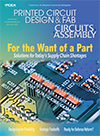Features Articles
Parity emerges among EMS Factories from Asia, Mexico and the US.
For the first time in years we see parity in the Eastern US among EMS factories from Asia, Mexico and the US. This EMS market condition will permit American OEMs (the EMS industry refers to OEMs as customers) to have more EMS pathways to choose from. Now more than ever, such EMS assignments will require deeper investigation relating to the OEMs’ evaluation of manufacturing strategies.

Thin boards are prone to vacuum suction, increasing the risk of over-prints.
Despite the provocative headline, this column is not a rant about how much I despise defects or the havoc they wreak on yields and profits; that’s already well established! Rather, this month’s space will focus on dedicated tooling and print platform vacuum control.

One culprit could be package warping.
Figure 1 shows the Amkor TMV package after microsectioning the board assembly during failure analysis. This particular view shows open joints between the top package and the solder spheres on the bottom package.
Connectivity is embedded in the electronics ecosystem. And test should be embedded in the devices that support it.
The Internet of Things (IoT) is the new buzzword coined to describe the use of smart and connected electronic devices that enable greater efficiency and productivity in our daily lives.

Print and money: How the West’s inflexibility costs us all.
Some things our industry does are simply extraordinary!
The technology we’ve imagined, created, developed and harnessed has been nothing less than awe-inspiring.
Press Releases
- Coherix Opens New Adhesive-Dispensing Vision Center in Europe
- Pan Pacific Strategic Electronics Symposium Program Finalized
- The Most Critical 2 Inches in SMT Manufacturing – When a Splice Fails, the Line Fails, Full Stop. Throughput and Yield Depend on One Overlooked Moment
- Entrepix Signs Exclusive Representative Agreement with Legatech for the United Kingdom and Nordic Region




